Growing Up in Scotland: father-child relationships and child socio-emotional wellbeing
Research report providing insight into the nature of father-child relationships in Scotland.
Chapter 4: Current Predictors Of Poor Father-Child Relationships
4.1 Introduction
As outlined in the previous section, a substantial minority (16%) of ten year-old children in GUS couple families perceive low levels of supportiveness from fathers, and are categorised as having a "poor" father-child relationship. This section examines which current family circumstances, measured when children were ten years old, are associated with a poor father-child relationship. Rather than focusing solely on characteristics of the father or father figure, we consider a wide range of characteristics of the child, both parents and the household since these may all impinge on the father-child relationship. We first consider simple (bivariate) associations between each factor and father-child relationships. As many aspects of family disadvantage tend to co-occur, we then use a multivariable model to establish key current (age 10) predictors of poor father-child relationships ( section 4.6).
4.2 Key findings from the multivariable model
- Male child gender, lower family socio-economic status, unmarried parents, recent experience of adverse family events and living with a non-biological father figure are all current risk factors independently associated with poor father-child relationships
- Some risk factors for poor father-child relationships (male child gender, lower family socio-economic status) are also risk factors for poor mother-child relationships
- Some risk factors (unmarried parents, non-biological father figure, adverse family events) are important for father-child, but not mother-child relationships
- Risk factors for poor father-child relationships are similar for boys and girls
4.3 Child characteristics
As shown in section 3.2, boys are more likely to have a poor father-child relationship than girls. However, the child's physical health (according to body mass index measures and parent reported general health) was not associated with fathers' supportiveness.
4.4 Socio-demographic factors
A number of current family characteristics are not associated with father-child relationship quality (parent's ethnicity, household employment, number of children in the household, area deprivation, and urban-rural location).
There is a significant association between mother's age and father-child relationship quality, in that children with younger mothers (under 40 years at the child aged 10 interview and therefore under 29 at the time of the child's birth) are more likely to have a poor father-child relationship (Figure 4-A). Whilst there also seems to be a trend for the proportion of children perceiving poor father-child relationships decreasing as the father's age increases, this is not statistically significant.
Figure 4-A Association between parental age and poor father-child relationship
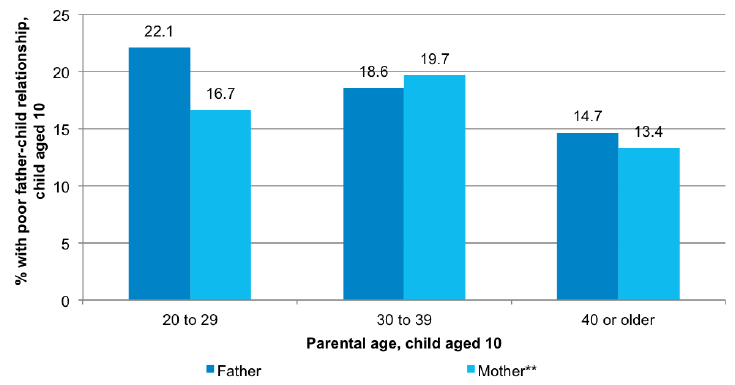
Note: Base sample n=2593 (unweighted). Asterisks indicate statistically significant association between mothers' age and poor father-child relationship, ** p<0.01.
As we can see from Figure 4-B, the proportion of children with a poor father-child relationship decreases as the level of parental educational qualifications increases. Father's and mother's educational level both show the same trend. When parental education level is merged, taking the highest education level within the couple, the association with poor father-child relationship remains significant ( p<0.001).
Figure 4-B Associations between parental education level and father-child relationship quality
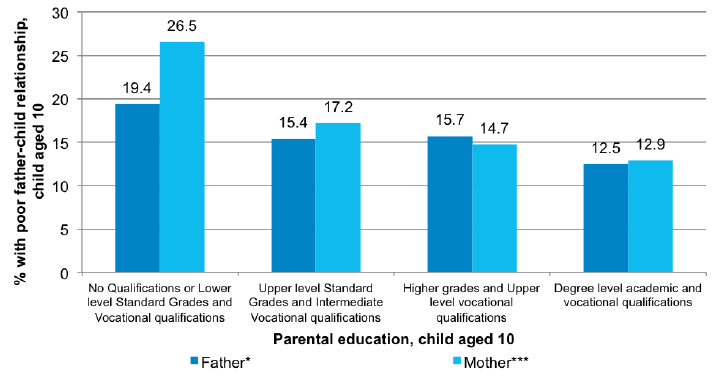
Note: Base sample of all couples with male partner in household n=2593 (unweighted). Asterisks indicate statistically signficant linear association between educational level and poor father-child relationship, * p<0.05, *** p<0.001.
Figure 4-C shows a similar trend for household income, with fewer children having a poor father-child relationship at higher levels of household income.
Figure 4-C Associations between household income and father-child relationship
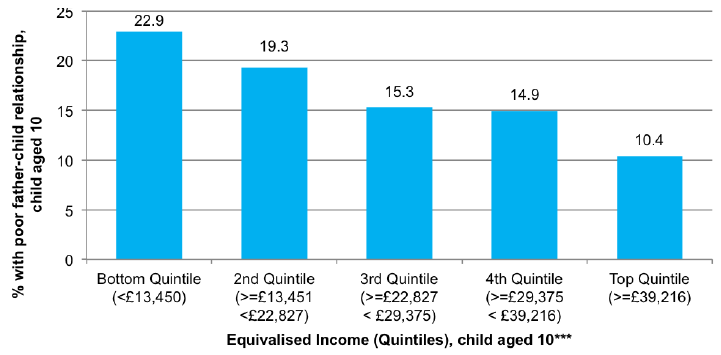
Note: Base sample of all couples with male partner in household n=2593 (unweighted). Household income was equivalised to take account of household size and compostion. Asterisks indicate a statistically signficant linear association between income and poor father-child relationship, *** p<0.001
Fathers' and mothers' occupational class both show a similar trend (see Figure 4-D for fathers' occupational class). Children of parents in professional/managerial occupations are least likely to perceive a poor relationship with their father, and children of parents in routine occupations most likely to do so.
Figure 4-D Associations between parental occupational class and father-child relationship
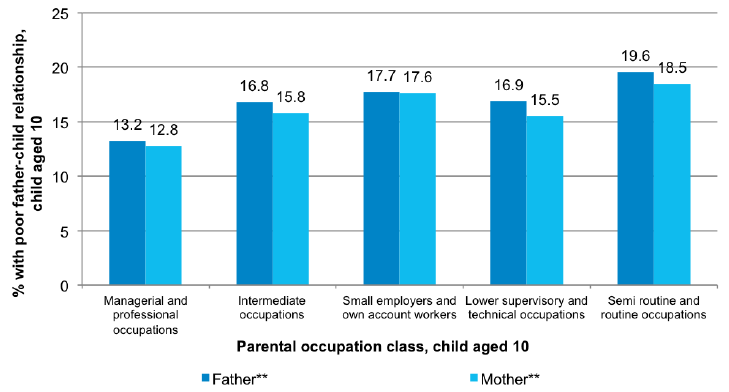
Note: Base sample n=2593 (unweighted). Occupation based on National Statistics Socio-economic Classification ( NS-SeC) six-fold classification, excluding "never worked". **denotes significant (linear) association between occupational class and father-child relationship, p<0.01.
The effect of fathers' longer working hours also appears to reflect higher income levels rather than decreased availability, at least up to a certain point. The EU maximum threshold for working hours is 48 hours per week. Up to this EU threshold, a poor-child relationship appears less likely, the longer fathers work. With working hours longer than this, it appears that more children have a poor father-child relationship (Figure 4-E). Nevertheless, the difference between this group (23% of fathers) and the majority working less than 48 hours is not statistically significant.
Figure 4-E Associations between parental working hours and father-child relationship
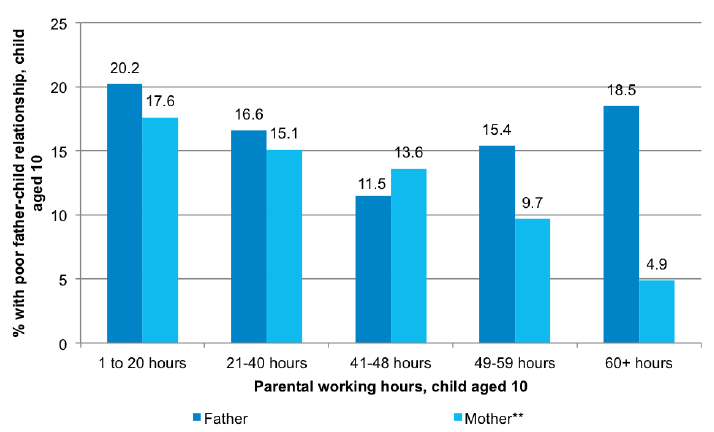
Note: Base sample of all couples with male partner in household n=2593 (unweighted). Asterisks denote statistically significant (linear) association for mother's working hours with father-child relationship, p<0.01.
Mothers' working hours show a more uniform trend to be inversely associated with the proportion of children having a poor father -child relationship. In other words, the longer the mother's working hours, the less likelihood there is that the child has a poor relationship with the father. This raises the question of whether fathers tend to spend more time with children when the mother works, and develop a better relationship with them. In order to address this question, we need to examine the overall pattern of employment in the household. We look both at who was the main breadwinner, and at the effect of one or both parents working relatively long hours. We find no difference in the proportion of families with poor father-child relationships according to whether the mother or father is the main breadwinner (Figure 4-F). Furthermore, although relatively few mothers (8%) work more than 40 hours per week, when mothers are employed in this way, father-child relationships do not vary according to whether fathers have shorter hours (Figure 4-G). This suggests that it is not the length of time that fathers spend at home that explains the quality of the father-child relationship. These findings also suggest that the effect seen in Figure 4-E for mothers' hours is likely to reflect the effects of higher income and maternal education on families, rather than a shift in the main carer from the mother to the father.
Figure 4-F Association between household employment pattern and father-child relationship
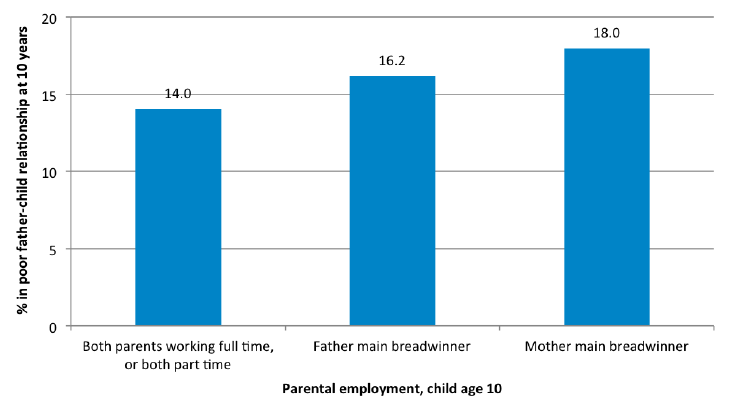
Note: base sample (unweighted) n=2489 families where at least one parent was working
Figure 4-G Association between parents' joint working hours and father-child relationship
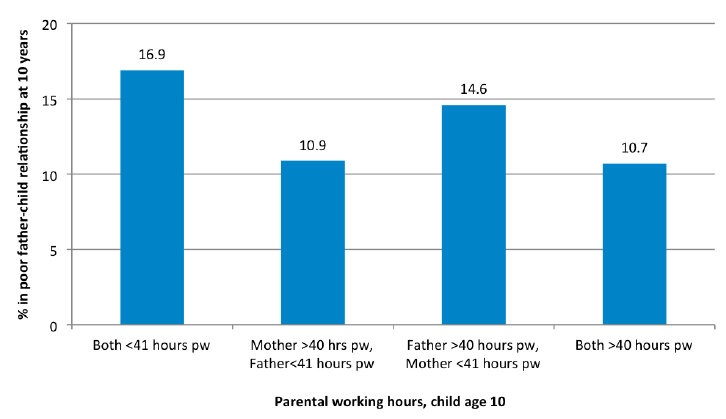
Note: base sample (unweighted) n=2593 families
Among families where the child's parents are married, 13.8% of children have a poor relationship compared to 24.1% of families with unmarried parents (Figure 4-H). Figure 4-H also reminds us (see 3.3) that if the family contains a father figure, there is more risk of a poor-father child relationship than if the biological father is present. Although this graph suggests that a more recent father figure carries more risk of a poor father-child relationship compared to an establised father figure, the difference between established and recent father figures is not statistically significant (see section 3.3 for definitions of "established" and "recent").
Figure 4-H Association between aspects of parental relationship status and poor father-child relationship
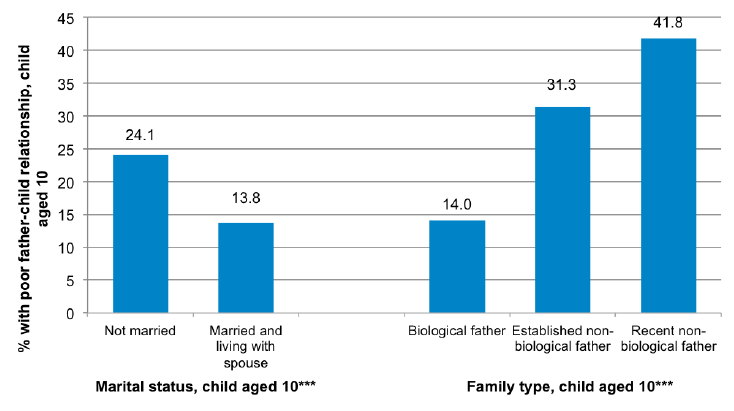
Note: Base sample n=2593 (unweighted). Asterisks denote a statistically significant association for both marital status and family type with father-child relationship, *** p<0.001
4.5 Family adversity
Children experiencing multiple adverse family events such as family illness, accidents and deaths in the recent past (i.e the two-year interval since the previous GUS survey) are more likely to have a poor father-child relationship (Figure 4-I). More detailed investigation failed to find an association between any particular type of event and risk of a poor father-child relationship, with the exception of marriage between parents. This reflects the presence of a non-biological father figure in the family, rather than marriage between two biological parents. Only 1% of families with both biological parents mentioned getting married in the two years prior to the age 10 interview, compared to 16% of families with a non-biological father figure.
Figure 4-I Associations between adverse family events and father-child relationship
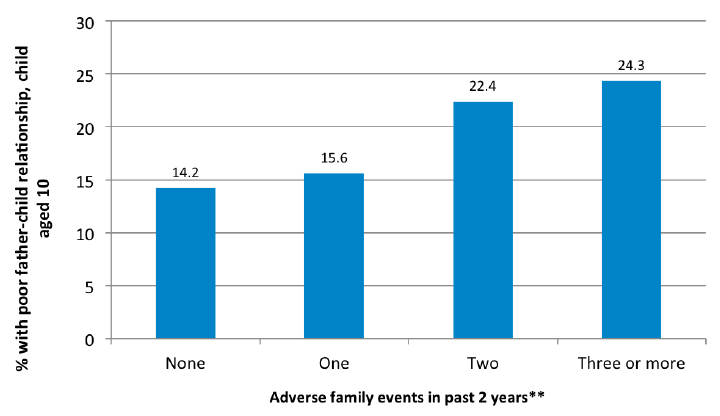
Note: Base sample n=2593 (unweighted). Asterisks indicate a significant (linear) association between adverse family events and father-child relationship, ** p<0.01
4.6 Multivariable model of current predictors of poor father-child relationship
A multivariable regression was used to explore current factors that were associated with poor father-child relationship, as identified above. Being a male child, lower parental education, unmarried parents, having a father figure and recent experience of adverse family events all emerged as statistically significant predictors of a poor father-child relationship. Both "recent" and "established" father figures appeared to carry a similar level of risk.
There were no differences in the effect of risk factors according to the child's gender. In other words, risk factors for poor father-child relationships such as having a non-biological father figure were equally important for boys and girls. There were also no differences in the effect of having a father figure according to whether or not parents were married.
A similar multivariable model was created of poor mother-child relationships. This found that male child gender, low parental education and lower family income were all associated with a poor mother-child relationship. Unlike the model of poor father-child relationship, there were no independent effects of parental marital status, presence of a non-biological father figure or adverse family events on the likelihood of a poor mother-child relationship.
Contact
Email: Wendy van der Neut
There is a problem
Thanks for your feedback